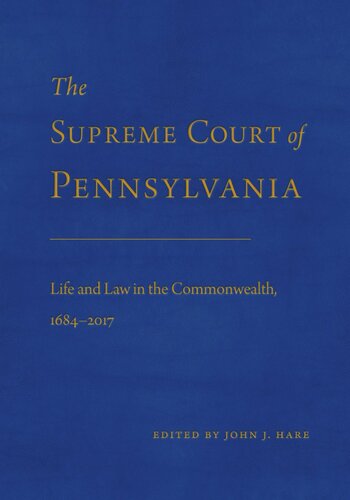

Most ebook files are in PDF format, so you can easily read them using various software such as Foxit Reader or directly on the Google Chrome browser.
Some ebook files are released by publishers in other formats such as .awz, .mobi, .epub, .fb2, etc. You may need to install specific software to read these formats on mobile/PC, such as Calibre.
Please read the tutorial at this link: https://ebookbell.com/faq
We offer FREE conversion to the popular formats you request; however, this may take some time. Therefore, right after payment, please email us, and we will try to provide the service as quickly as possible.
For some exceptional file formats or broken links (if any), please refrain from opening any disputes. Instead, email us first, and we will try to assist within a maximum of 6 hours.
EbookBell Team

4.1
80 reviewsEstablished in 1684, over a century before the Commonwealth, Pennsylvania’s Supreme Court is the oldest appellate court in North America. This balanced, comprehensive history of the Court examines over three centuries of legal proceedings and cases before the body, the controversies and conflicts with which it dealt, and the impact of its decisions and of the case law its justices created
Introduced by constitutional scholar Ken Gormley, this volume describes the Supreme Court’s structure and powers and focuses at length on the Court’s work in deciding notable cases of constitutional law, civil rights, torts, criminal law, labor law, and administrative law. Through three sections, “The Structure and Powers of the Supreme Court,” “Decisional Law of the Supreme Court,” and “Reporting Supreme Court Decisions,” the contributors address the many ways in which the Court and its justices have shaped life and law in Pennsylvania and beyond. They consider how it has adjudicated new and complex issues arising from some of the most notable events and tragedies in American history, including the struggle for religious liberty in colonial Pennsylvania, the Revolutionary War, slavery, the Johnstown Flood, the Homestead Steel Strike and other labor conflicts, both World Wars, and, more recently, the dramatic rise of criminal procedural rights and the expansion of tort law.
Featuring an afterword by Chief Justice Saylor and essays by leading jurists, deans, law and history professors, and practicing attorneys, this fair-minded assessment of the Court is destined to become a criterion volume for lawmakers, scholars, and anyone interested in legal history in the Keystone State and the United States.